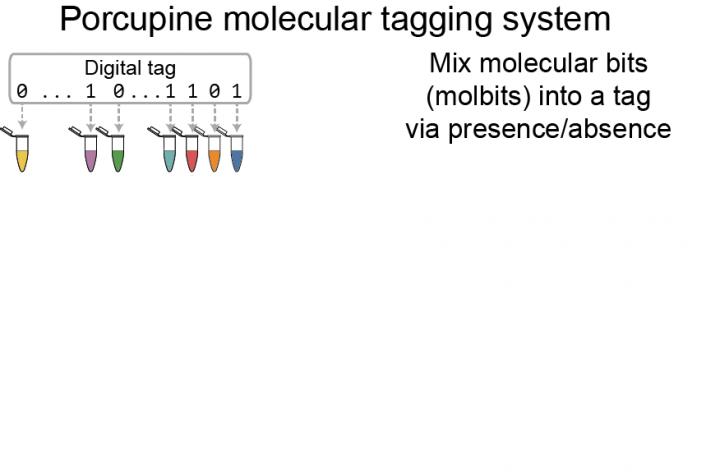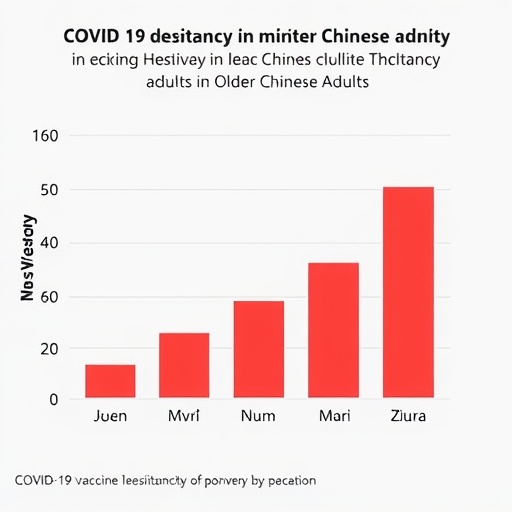
Credit: Kathryn Doroschak/University of Washington
Many people have had the experience of being poked in the back by a plastic tag while trying on clothes in a store. That is just one example of radio frequency identification technology, which has become a mainstay not just in retail but also in manufacturing, logistics, transportation, health care and more. Other tagging systems include the scannable barcode and the QR code.
Despite their near ubiquity, these object tagging systems have their shortcomings: They may be too large or inflexible for certain applications, they are easily damaged or removed, and they may be impractical to apply in high quantities. But recent advancements in DNA-based data storage and computation offer new possibilities for creating a tagging system that is smaller and lighter than conventional methods.
That’s the point of Porcupine, a new molecular tagging system introduced by University of Washington and Microsoft researchers. These tags can be programmed and read within seconds using a portable nanopore device. In a new paper published Nov. 3 in Nature Communications, the team describes how dehydrated strands of synthetic DNA can take the place of bulky plastic or printed barcodes. Building on recent developments in DNA sequencing technologies and raw signal processing tools, the team’s inexpensive and user-friendly design forgoes the need for access to specialized labs and equipment.
“Molecular tagging is not a new idea, but existing methods are still complicated and require access to a lab, which rules out many real-world scenarios,” said lead author Kathryn Doroschak, a UW doctoral student in the Paul G. Allen School of Computer Science & Engineering. “We designed the first portable, end-to-end molecular tagging system that enables rapid, on-demand encoding and decoding at scale, and which is more accessible than existing molecular tagging methods.”
Instead of radio waves or printed lines, the Porcupine tagging scheme relies on a set of distinct DNA strands called molecular bits, or “molbits” for short, that incorporate highly separable nanopore signals to ease later readout. Each individual molbit comprises one of 96 unique barcode sequences combined with a longer DNA fragment selected from a set of predetermined sequence lengths. Under the Porcupine system, the binary zeros and ones of a digital tag are signified by the presence or absence of each of the 96 molbits.
“We wanted to prove the concept while achieving a high rate of accuracy, hence the initial 96 barcodes, but we intentionally designed our system to be modular and extensible,” said co-author Karin Strauss, senior principal research manager at Microsoft Research and affiliate professor in the Allen School. “With these initial barcodes, Porcupine can produce roughly 4.2 billion unique tags using basic laboratory equipment without compromising reliability upon readout.”
Although DNA is notoriously expensive to read and write, Porcupine gets around this by prefabricating the fragments of DNA. In addition to lowering the cost, this approach has the added advantage of enabling users to arbitrarily mix existing strands to quickly and easily create new tags. The molbits are prepared for readout during initial tag assembly and then dehydrated to extend the shelf life of the tags. This approach protects against contamination from other DNA present in the environment while simultaneously reducing readout time later.
Another advantage of the Porcupine system is that molbits are extremely tiny, measuring only a few hundred nanometers in length. In practical terms, this means each molecular tag is small enough to fit over a billion copies within one square millimeter of an object’s surface. This makes them ideal for keeping tabs on small items or flexible surfaces that aren’t suited to conventional tagging methods. Invisible to the naked eye, the nanoscale form factor also adds another layer of security compared to conventional tags.
“Unlike existing inventory control methods, DNA tags can’t be detected by sight or touch. Practically speaking, this means they are difficult to tamper with,” said senior author Jeff Nivala, a research scientist at the Allen School. “This makes them ideal for tracking high-value items and separating legitimate goods from forgeries. A system like Porcupine could also be used to track important documents. For example, you could envision molecular tagging being used to track voters’ ballots and prevent tampering in future elections.”
To read the data in a Porcupine tag, a user rehydrates the tag and runs it through a portable nanopore device. To demonstrate, the researchers encoded and then decoded their lab acronym, “M-I-S-L,” reliably and within a few seconds using the Porcupine system. As advancements in nanopore technologies make them increasingly affordable, the team believes molecular tagging could become an increasingly attractive option in a variety of real-world settings.
“Porcupine is one more exciting example of a hybrid molecular-electronic system, combining molecular engineering, new sensing technology and machine learning to enable new applications,” said co-author Luis Ceze, a professor in the Allen School.
###
p>Other contributors to the project include Allen School undergraduate student Karen Zhang, master’s student Aishwarya Mandyam and doctoral student Melissa Queen. This research was funded in part by the Defense Advanced Research Project Agency under its Molecular Informatics Program and gifts from Microsoft.
For more information contact Doroschak at [email protected] and Nivala at [email protected].
Media Contact
Sarah McQuate
[email protected]




